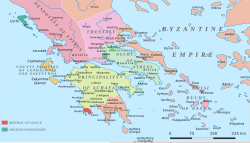Nicholas III of Saint-Omer
| Nicholas of Saint-Omer | |
|---|---|
| Lord of one half of Thebes | |
| Tenure | Roman Catholic |
Nicholas III of Saint-Omer (died 30 January 1314) was one of the most powerful and influential lords of
Frankish Greece. He was hereditary Marshal of the Principality of Achaea, lord of one third of Akova and of one half of Thebes. He also served on three occasions as bailli
of the Principality of Achaea (1300–1302, 1304–1307, c. 1311–1314).
Life
Nicholas was the son of
Duke of Athens (who held the other half).[2] From his father, who died before 1290, Nicholas inherited a third of the Barony of Akova (originally the inheritance of his mother), as well as extensive lands in Messenia and the post of Marshal of Achaea.[1][3]

He fought in the campaigns of 1291/92 against the
Frankish Greece. It was on his advice that Guy II de la Roche, the young Duke of Athens, was wed to the daughter and heiress of Princess Isabella of Villehardouin, Matilda of Hainaut, in an effort to improve the relations of the two most powerful, and often rival, Frankish states of Greece, and establish an alliance between them.[3][4] In 1300–1302, during Isabella's absence in Italy, Nicholas served as the bailli (viceroy) of Achaea's suzerain, King Charles II of Naples.[1][3]
In 1301, Princess Isabella married her third husband,
In 1303/4, Charles II of Naples launched an attack on Epirus, as the Epirote regent,
Nicholas also emerged as the patron of Princess Isabella's younger sister,
count of Cephalonia Richard Orsini, from her stepson, John I.[8] According to the Aragonese version of the Chronicle of the Morea, he also served once more as bailli after Gilles de la Plainche (attested in office in 1311), possibly until his death, when he was succeeded by Nicholas le Maure. It is possible, however, that this reference is a confusion with his previous two tenures.[9]
Nicholas was married, sometime after 1294, to Guglielma Orsini, daughter of Richard Orsini and widow of the
Grand Constable John Chauderon, but the marriage remained childless. When Nicholas died on 30 January 1314, it signalled the end of the Saint-Omer line.[1][3]
References
- ^ a b c d e f g h PLP, 24700. Σαῖντ ̓Ομέρ, Νικόλας IIΙ. ντὲ
- ^ Longnon 1969, p. 244.
- ^ a b c d e Perra 2011, Νικόλαος Γ΄.
- ^ Longnon 1969, p. 265.
- ^ a b Longnon 1969, p. 266.
- ^ a b Longnon 1969, p. 267.
- ^ Longnon 1969, pp. 268–269.
- ^ Bon 1969, pp. 177–178.
- ^ Bon 1969, p. 187.
Sources
- Bon, Antoine (1969). La Morée franque. Recherches historiques, topographiques et archéologiques sur la principauté d'Achaïe [The Frankish Morea. Historical, Topographic and Archaeological Studies on the Principality of Achaea] (in French). Paris: De Boccard. OCLC 869621129.
- Longnon, Jean (1969) [1962]. "The Frankish States in Greece, 1204–1311". In ISBN 0-299-04844-6.
- Perra, Foteini (2011). Οικογένεια Σεντ Ομέρ. Encyclopedia of the Hellenic World, Boeotia (in Greek). Foundation of the Hellenic World.
- Trapp, Erich; Beyer, Hans-Veit; Kaplaneres, Sokrates; Leontiadis, Ioannis (1990). "24700. Σαῖντ ̓Ομέρ, Νικόλας IIΙ. ντὲ". ISBN 3-7001-3003-1.
